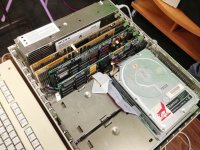bear
Well-known member
Here is the answer to the riddle:
The trace between the + side of C14 and pin 10 of UI14 (the Sony sound chip closer to the MC68020) had come open. I repaired it and the II lives. Or at least, gives me death chimes, which is expected since I have no RAM in it while it's on the bench. (The next step will be to start buttoning it all back up and see how far we get with that.)
Sadly the results came out of a bunch of guess-and-check hunch-work, rather than any concrete info. Trying to guess how the reset circuit worked, I found one (but only one) of the Sony sound chips connected to it, but didn't know why. Later, when looking for a clock line I could get at with a logic analyzer (to see if the clock was even working) I discovered that that same Sony sound chip (but again only that one) was connected to it (and didn't know why this either).
Guessing that it must have something to do with controlling the clock during an external reset and possibly also bringing the RESET line high at the appropriate time (after the right number of clock cycles), I observed on my one good II that the clock stops for as long as you hold the reset switch in. Checking the bad II, I found the clock stopping and starting itself at intervals, and that if I pushed the reset switch the clock would stop and never start again. So I began to think that that Sony chip might not be a bad place to start looking.
There was no change in behavior after I replaced it (UI14). Even though neither CLOCK nor RESET are connected to the other Sony chip (UI16), the two Sony chips are connected to each other, so it seemed reasonable that a fault with UI16 could cause UI14 to malfunction with a corresponding glitch on RESET. When I cut UI16 off the board to replace it, I found some corrosion under it (collateral damage from leaked electrolyte, I'm sure) that hadn't come clean in the wash (in any of the washing). I got the idea to ohm out each of the three traces that run through there; sure enough, the above mentioned trace was open-circuit. Replaced UI16, bridged the trace... life.
Sweet.
I have enough spare Sony chips to do four more boards if it came to that, but I think maybe it won't be necessary for the next one.
The trace between the + side of C14 and pin 10 of UI14 (the Sony sound chip closer to the MC68020) had come open. I repaired it and the II lives. Or at least, gives me death chimes, which is expected since I have no RAM in it while it's on the bench. (The next step will be to start buttoning it all back up and see how far we get with that.)
Sadly the results came out of a bunch of guess-and-check hunch-work, rather than any concrete info. Trying to guess how the reset circuit worked, I found one (but only one) of the Sony sound chips connected to it, but didn't know why. Later, when looking for a clock line I could get at with a logic analyzer (to see if the clock was even working) I discovered that that same Sony sound chip (but again only that one) was connected to it (and didn't know why this either).
Guessing that it must have something to do with controlling the clock during an external reset and possibly also bringing the RESET line high at the appropriate time (after the right number of clock cycles), I observed on my one good II that the clock stops for as long as you hold the reset switch in. Checking the bad II, I found the clock stopping and starting itself at intervals, and that if I pushed the reset switch the clock would stop and never start again. So I began to think that that Sony chip might not be a bad place to start looking.
There was no change in behavior after I replaced it (UI14). Even though neither CLOCK nor RESET are connected to the other Sony chip (UI16), the two Sony chips are connected to each other, so it seemed reasonable that a fault with UI16 could cause UI14 to malfunction with a corresponding glitch on RESET. When I cut UI16 off the board to replace it, I found some corrosion under it (collateral damage from leaked electrolyte, I'm sure) that hadn't come clean in the wash (in any of the washing). I got the idea to ohm out each of the three traces that run through there; sure enough, the above mentioned trace was open-circuit. Replaced UI16, bridged the trace... life.
Sweet.
I have enough spare Sony chips to do four more boards if it came to that, but I think maybe it won't be necessary for the next one.





